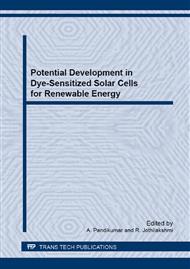[1]
B. O'Regan and M. Grätzel, A low-cost, high-efficiency solar cell based on dye-sensitized colloidal TiO2 films, Nature 353 (1991) 737–740.
DOI: 10.1038/353737a0
Google Scholar
[2]
Y. Chiba, A. Islam, Y. Watanabe, R. Komiya, N. Koide and L. Han, Dye-sensitized solar cells with conversion efficiency of 11.1%. Jpn. J. Appl. Phys., 45 (2006) 638-640.
DOI: 10.1143/jjap.45.l638
Google Scholar
[3]
M. Zukalova, A. Zuka, L. Kavan, M. K. Nazeeruddin, P. Liska and Michael Grätzel, Organized mesoporous TiO2 films exhibiting greatly enhanced performance in dye-sensitized solar cells, Nano Lett. 5 (2005) 1789-1792.
DOI: 10.1021/nl051401l
Google Scholar
[4]
Yu-Chang Liu, Yun-Fang Lu, Yz-Zhen Zeng, Chi-Hung Liao, Jen-Chieh Chung, and Tsong-Yang Wei, Nanostructured mesoporous titanium dioxide thin film prepared by sol-gel method for dye-sensitized solar cell, Int. J. Photoenergy, 619069 (2011) 9.
DOI: 10.1155/2011/619069
Google Scholar
[5]
C. Xu, J. Wu, U. V. Desai and D. Gao, High-efficiency solid-state dye-sensitized solar cells based on TiO2-coated ZnO nanowire Arrays, Nano Lett., 12 ( 2012 ) 2420–2424
DOI: 10.1021/nl3004144
Google Scholar
[6]
V. Baglio, M. Girolamo, V. Antonucci, A. S. Aricò, Influence of TiO2 film thickness on the electrochemical behaviour of dye-sensitized solar cells, Int. J. Electrochem. Sci., 6 (2011) 3375–3384.
Google Scholar
[7]
S. Kambe, S. Nakade, Y. Wada, Effects of crystal structure, size, shape and surface structural differences on photo-induced electron transport in TiO2 mesoporous electrodes. J. Mater. Chem. 12 (2002) 723-728.
DOI: 10.1039/b105142n
Google Scholar
[8]
J. Jin, The finite element method in electromagnetics, Wiley Press, New York (2002).
Google Scholar
[9]
D. Jyoti, D. Mohan, R. Dhar and Purnima, Influence of electrode thickness on the performance of dye-sensitized solar cells, Invertis J. Renewable Energy, 1(2) (2011) 108.
Google Scholar
[10]
D. Jyoti and D. Mohan, Optimization of photoelectrode porosity using simulation analysis for dye-sensitized solar cells, Int. J. Sci. Eng. Comput. Technol. 2 (2012) 83.
Google Scholar



